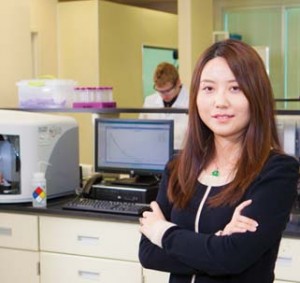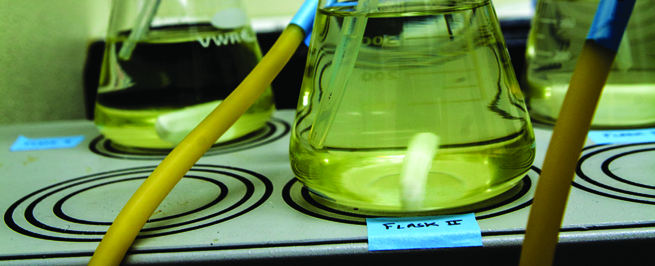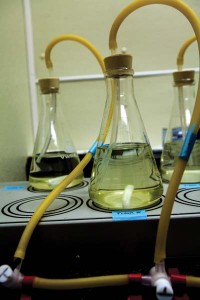
If this is the right direction, not only will this lower phosphorus, but it can also help with energy consumption.
Wen Zhang, assistant professor of civil engineering
In Wen Zhang’s lab, flasks of pale green water sit on a table. Magnets under the flasks spin plastic cylinders, stirring the water. The color comes from particles of Chlorella Vulgaris, a type of algae. Zhang and her students are cultivating this algal species to study its use in reducing phosphorus in wastewater.
From Pollution to Prevention
The idea of adding algae to the wastewater treatment process is counterintuitive. Since algae thrive on an overabundance of phosphorus in water, algal blooms in lakes and ponds are a sign of water pollution, and they can lead to further water quality issues. Zhang explained that the problem is the decomposition of the algal cells.
“When algae are alive and carry on photosynthesis, that’s definitely good, because they are degrading nutrients and producing oxygen,” she explained. “But when algae die, bacteria in the water decompose the algal cells. And when they do that, they consume a lot more oxygen in the water, and that will drop the oxygen levels significantly, to a level where it becomes dark and smells.
“We are trying to reverse this process,” Zhang explained. She is hoping to use the relationship between phosphorus and algae to improve the efficiency of wastewater processing.
Lowering the Goal
Traditionally, bacteria are used to remove nutrients such as nitrogen and phosphorus from wastewater. Zhang explained that currently, wastewater treatment plants can achieve phosphorus levels of around 8-10 milligrams per liter of water using this method. In 2002, however, Oklahoma passed a regulation requiring that total phosphorus concentration in scenic rivers not exceed 0.037 milligrams per liter of water. Zhang explained that Arkansas is also expected to pass regulations to reduce the amount of phosphorus discharge from wastewater treatment plants soon, possibly to levels below 1 milligram per liter of water.To reach this goal using only conventional methods, treatment plants would have to add additional phases to their systems, which would be costly, or use chemicals to precipitate the phosphorus out of the water, which creates chemical waste.
Zhang is developing an alternative: adding algae to the treatment process. She envisions a reactor with algae attached to surfaces inside. As part of the treatment process, wastewater would enter the algae reactor, and the algae would remove phosphorus from the water. In addition, the algae could easily be harvested and used to produce biofuels.
Testing the Hypothesis
Currently, Zhang and her students are investigating all the steps in this process. The algae they are growing in the lab will be put in a specially designed bioreactor, which they will fill with wastewater effluent from a local treatment plant. The researchers will measure phosphorus levels in the water before and after it is exposed to the algae in order to see how effective their system is.Zhang also hopes her algae will also be a good source of biofuel. Giving the algae a surface to attach to stimulates the cells to produce extra-cellular polymeric substance, or EPS, which acts like a glue. EPS contains lipids, which can be extracted and converted into biodiesel, a sustainable alternative to fossil fuels.
Zhang, who came to the university in the fall of 2011, sees a lot of potential for the project. “If this is the right direction,” she said, “not only will this lower phosphorus, but it can also help with energy consumption.”


